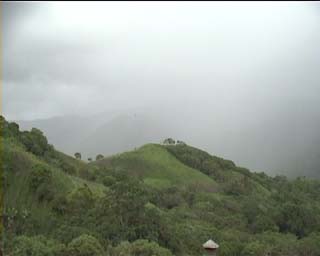

h|u|m|b|o|t
[about]
[+] next
[-] previous
[f] found entries
[w] word entries
[V] unfold
[x] close
| [x] |
The beach near the mouth of the small Santa Catalina river is lined with mangrove trees (Rhizophora mangle); but these mangroves (manglares) are not extensive enough to affect the salubrity of Cumana's air. Otherwise the plain is partly bare and partly covered with tufts of plants including the Avicennia tomentosa, the Scoparia dulcis, a shrub-like mimosa with very sensitive leaves, (28) and especially cassias, so many of which can be found in South America that on our travels we gathered more than thirty new species. |
| [x] |
Lake Valencia, called Tacarigua by the Indians, is larger than Lake Neuchâtel in Switzerland; its general form resembles Lake Geneva, situated at about the same altitude. Its opposite banks are notably different: the southern one is deserted, stripped of vegetation and virtually uninhabited; a curtain of high mountains gives it a sad, monotonous quality; in contrast, the northern side is pleasant and rural, and has rich plantations of sugar cane, coffee and cotton. Paths bordered with cestrum, azedaracs, and other perpetually flowering shrubs cross the plain and link the isolated farms. All the houses are surrounded by trees. The ceiba (Bombax hibiscifolius), with large yellow flowers, and the erythrina, with purple ones, whose overlapping branches give the countryside its special quality. During the season of drought, when a thick mist floats above the burning ground, artificial irrigation keeps the land green and wild. Every now and then granite blocks pierce through the cultivated ground; large masses of rocks rise up in the middle of the valley. Some succulent plants grow in its bare and cracked walls, preparing mould for the coming centuries. Often a fig tree, or a clusia with fleshy leaves, growing in clefts, crowns these isolated little summits With their dry withered branches they look like signals along a cliff. The shape of these heights betrays the secret of their ancient origins; for when the whole valley was still submerged and waves lapped the foot of the Mariara peaks (El Rincòn del Diablo) and the coastal chain, these rocky hills were shoals and islands. |
| [x] |
In several families I found a feeling for culture. They know about the great works of French and Italian literature; music pleases them, and is played with talent, which like all of the arts unites the different social classes. The exact sciences, and drawing and painting, are not as well established here as they are in Mexico and Bogota', thanks to the liberality of the government and the patriotism of the Spanish people. |
| [x] |
The Indians who go harvesting take thousands of dried or lightly cooked eggs away to their villages. Our towers always had some in baskets or cotton bags. When they are well preserved the taste is not too bad. They showed us large turtle shells emptied by jaguars, who wait for the turtles on the beach where the eggs are laid. They attack them on the sand. To eat them they turn them upside down so that the undershell is right-side up. In this position the turtles cannot right themselves, and as jaguars turn many more over than they can eat in one night the Indians avail themselves of the cats' greed and cunning. If you think how hard it is for a travelling naturalist to pull the turtle's body out without separating it from the cuirass of the shell you can only admire the litheness of the jaguar's paw as it empties the two-sided shield of the arrau as if the muscular ligaments had been severed by a surgeon. The jaguar chases turtles into the water, even digs up the eggs, and, along with the crocodile, heron and gallinazo vulture, is one of the cruellest enemies of the newborn turtles. When the first rains come called 'turtle rains' (peje canepori) - the wild Indians go along the Orinoco banks with their poisoned arrows and kill the turtles as they warm themselves in the sun. |
| [x] |
Over night the Orinoco had swollen and its faster current took us in ten hours the 13 leagues from the mouth of the Mataveni to the higher Maypures cataract, reminding us where we had camped coming up river. From the mouth of the Atabapo to that of the Apure we enjoyed travelling through a country in which we had long lived. We were just as squashed in the canoe and were stung by the same mosquitoes, but the certainty that in a few weeks our suffering would end kept our spirits up. |
| [x] |
In Cumana, on San Francisco hill with its convent, an intense stink of sulphur was smelled on the 14th of December 1797 half an hour before the great catastrophe. In this same place the underground noise was loudest. At the same time flames were seen on the Manzanares river banks near the Capuchin hospital, and in the Gulf of Cariaco near Mariguitar. This phenomenon, so strange in non-volcanic countries, happens frequently in the calcareous mountains near Cumanacoa, in the Bordones river valley, on Margarita Island and on the plains of New Andalusia. On these plains the sparks of fire rose to a considerable height and were seen for hours in the most arid places. Some asserted that when the ground through which the inflammable substances rose was examined not the smallest crack was found. This fire, which recalls the springs of methane or the Salse of Modena and the will-o'-the-wisp of our marshes, does not burn the grass. The people, though less superstitious here than in Spain, call these reddish flames by the odd name of The Soul of the Tyrant Aguirre; imagining that the ghost of Lope de Aguirre, (29) harassed by remorse, wanders over these countries sullied by his crimes. |

